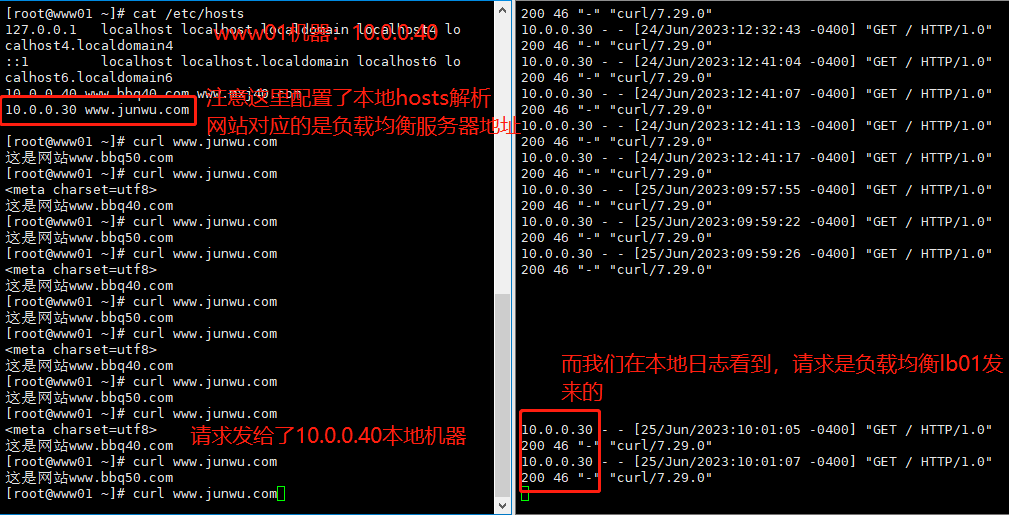Nginx反向代理&记录用户IP地址企业案例
反向代理机器节点: lb01 10.0.0.30 #lb01是反向代理服务器(包括负载均衡的功能) www01 10.0.0.40 www02 10.0.0.50
【演示反向代理功能】

图片解读:
- 使用客户端机器www01,访问负载均衡lb01(反向代理),看到了www01,www02页面信息
- 在www01服务器上检测客户端信息,发现请求是10.0.0.30发来的,这不是lb01吗
- 但是我们请求明明是www01发出的
这就是反向代理的含义,用户请求发送给了反向代理,反向代理再次发出一个请求
【如何解决这个问题呢,扑捉到真实的客户端的IP,而非代理服务器呢?】
X-Forwarded-For
在反向代理请求后端节点服务器的请求头中添加获取客户端IP的字段信息,然后在后端节点可以通过程序或者相关配置接收X-Forwarded-For传过来的真实用户的IP信息。
【lb01反向代理节点配置如下】
部分nginx.conf代码如下,注意重点修改的部分
upstream www_pools { server 10.0.0.40; server 10.0.0.50; } server { listen 80; server_name www.junwu.com; #charset koi8-r; #access_log logs/host.access.log main; location / { root html; index index.html index.htm; proxy_pass http://www_pools; proxy_set_header Host $host; #添加此处代码,代理服务器向后端发送HHTP请求时,请求头中添加该参数信息,用于后端服务器程序、日志等接受真实用户的IP,而非是代理服务器的IP proxy_set_header X-Forwarded-For $remote_addr; }
重新加载lb01的nginx
[root@lb01 ~]# nginx -s reload
特别注意,不仅要在代理服务器配置,添加获取真实IP的字段,还要在节点服务器中添加配置,接受用户真实的IP,配置日志格式等操作。
【修改节点服务器www01的nginx.conf】
部分代码修改如下,关注重点修改的部分
http { include mime.types; default_type application/octet-stream; #重点在于此处,添加结尾的参数$http_x_forwarded_for,即可在日志中获取客户端的真实IP log_format main '$remote_addr - $remote_user [$time_local] "$request" ' '$status $body_bytes_sent "$http_referer" ' '"$http_user_agent" "$http_x_forwarded_for"'; #还有此处的日志格式配置,一定一定要在后面添加main参数,才能在日志中展现客户端IP access_log logs/access.log main; sendfile on; #tcp_nopush on; #keepalive_timeout 0; keepalive_timeout 65; #gzip on; server { listen 80; server_name www.bbq.com; #charset koi8-r; #access_log logs/host.access.log main; location / { root html/bbq; index index.html index.htm; } #error_page 404 /404.html; # redirect server error pages to the static page /50x.html # error_page 500 502 503 504 /50x.html; location = /50x.html { root html; } } server { listen 80; server_name www.mxj.com; #charset koi8-r; #access_log logs/host.access.log main; location / { root html/mxj; index index.html index.htm; }
测试效果一
检查10.0.0.40节点的日志信息 [root@www01 ~]# tail -f /opt/nginx-1.25.1/logs/access.log 10.0.0.30 - - [25/Jun/2023:10:56:31 -0400] "GET / HTTP/1.0" 200 46 "-" "curl/7.29.0" 10.0.0.30 - - [25/Jun/2023:10:56:33 -0400] "GET / HTTP/1.0" 200 46 "-" "curl/7.29.0" 10.0.0.30 - - [25/Jun/2023:10:56:52 -0400] "GET / HTTP/1.0" 200 46 "-" "curl/7.29.0" "10.0.0.40" 10.0.0.30 - - [25/Jun/2023:10:57:01 -0400] "GET / HTTP/1.0" 200 46 "-" "curl/7.29.0" "10.0.0.40" #日志解析 10.0.0.30显示的是远程访客的地址,也就是lb01负载均衡发来的请求 “10.0.0.40”是通过X-Forwarded-For参数获取到的真实客户端的ip
测试效果二
我们在另外一台节点服务器10.0.0.50上访问负载均衡器 [root@www02 ~]# curl www.junwu.com 这是网站www.bbq50.com [root@www02 ~]# curl www.junwu.com <meta charset=utf8> 这是网站www.bbq40.com [root@www02 ~]# curl www.junwu.com 这是网站www.bbq50.com ##然后在另一台www01节点服务器上查看日志 10.0.0.30 - - [25/Jun/2023:11:02:50 -0400] "GET / HTTP/1.0" 200 46 "-" "curl/7.29.0" "10.0.0.50" 最终通过日志,发现检测到了真实发请求的,其实是www02机器,ip为10.0.0.50
总结
- nginx的access.log日志,其日志格式里
$remote_addr变量,表示远程客户端的IP地址(可能是代理IP地址) - 其
$http_x_forwarded_for变量,是接收了在反向代理中配置的proxy_set_header X-Forwarded-For $remote_addr,获取了用户真实的IP(躲在代理IP后)
当然这里的X-Forwarded-For并不是万能的,所谓道高一尺魔高一丈,对于代理的形式还有很多种。
只有经历过生活的苦难
才会更加努力去生活
自己梦想的一切
更加需要自己脚踏实地的去践行
结果未必尽如人意
但是路途中的努力
一定比结果更加美丽
----by ljw



